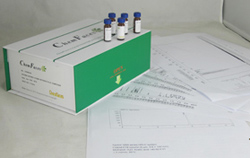Hot Products



| Catalog No. | Information |
| CFN96094 | Gamma-Methoxyisoeugenol Methyl Isoeugenol has antioxidant activity. |
| CFN92817 | Gamma-Tocotrienol Gamma-Tocotrienol has antioxidant activity, it as a hypocholesterolemic and antioxidant agent in rats fed atherogenic diets. Gamma-Tocotrienol is a novel blocker of the STAT3 activation pathway, it can induce the apoptosis on human gastric cancer SGC-7901 cells via mitochondria-dependent apoptosis pathway, with a potential role in future therapies for HCC and other cancers. |
| CFN96524 | Gancaonin G Gancaonin G shows antibacterial effects on the MRSA strains with MIC values of 16 microg/ml, it also shows more moderate antibacterial activity against Streptococcus mutans. |
| CFN96842 | Gancaonin I Gancaonin I exhibits anti-BsFtsZ GTPase activities; it also shows significant inhibitory activity against B. subtilis, with a MIC value of 5 uM. |
| CFN95066 | Gancaonin N Reference standards. |
| CFN90306 | Ganoderal A The oxygenated sterols( 26-oxygenosterols ganoderol A, ganoderol B, ganoderal A, and ganoderic acid Y) from G. lucidum can inhibit cholesterol biosynthesis via conversion of acetate or mevalonate as a precursor of cholesterol. |
| CFN92236 | Ganoderenic acid A Ganoderenic acid A has a potent hepatoprotective, and cytotoxic effects, it shows inhibitory activity on human aldose reductase in vitro. |
| CFN92991 | Ganoderenic acid B Ganoderenic acid B can enhance the cytotoxicity of chemotherapeutics towards ABCB1-mediated MDR cancer cells via inhibition of the transport function of ABCB1. |
| CFN92238 | Ganoderenic acid C Reference standards. |
| CFN90300 | Ganoderenic acid D Ganoderenic acid D is most cytotoxic with IC50 values of 0.14 ± 0.01, 0.18 ± 0.02 and 0.26 ± 0.03 mg/mL in Hep G2, Hela and Caco-2 cells, respectively. |